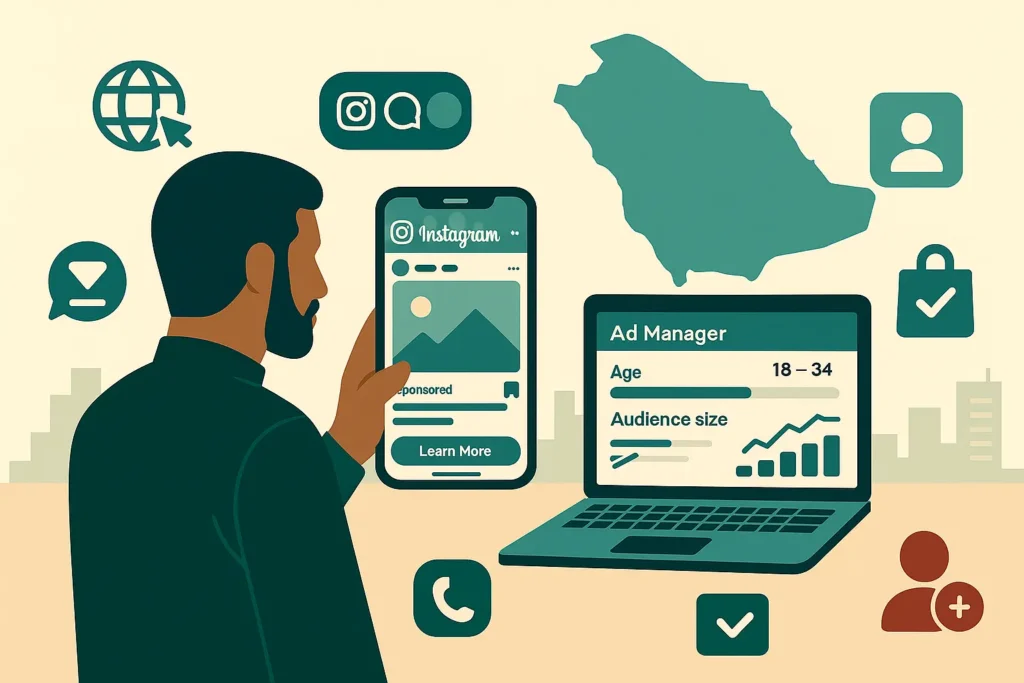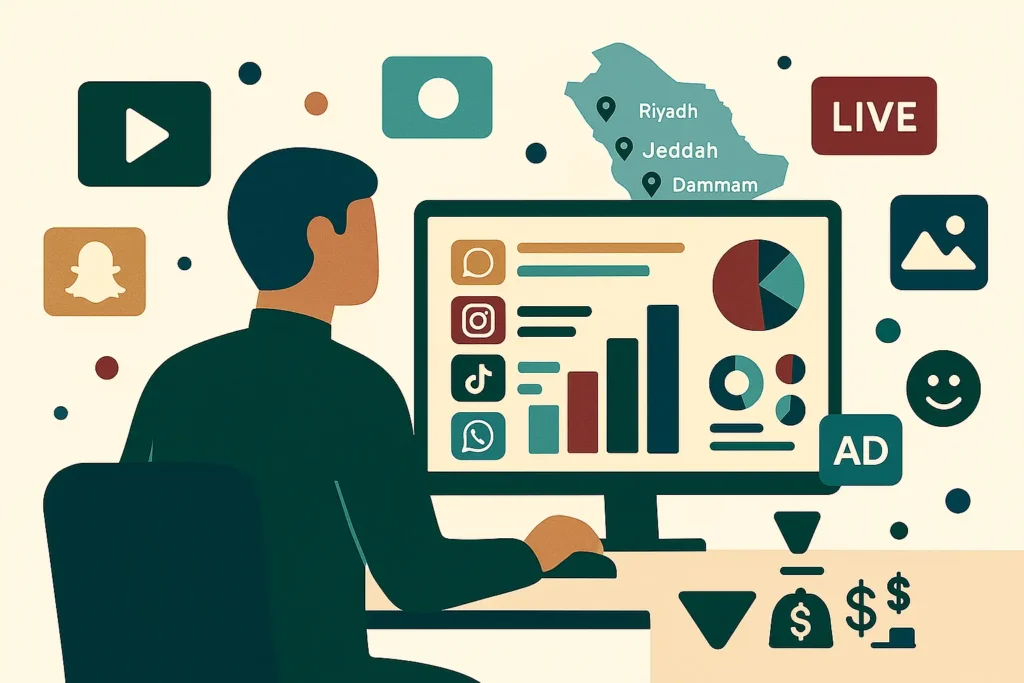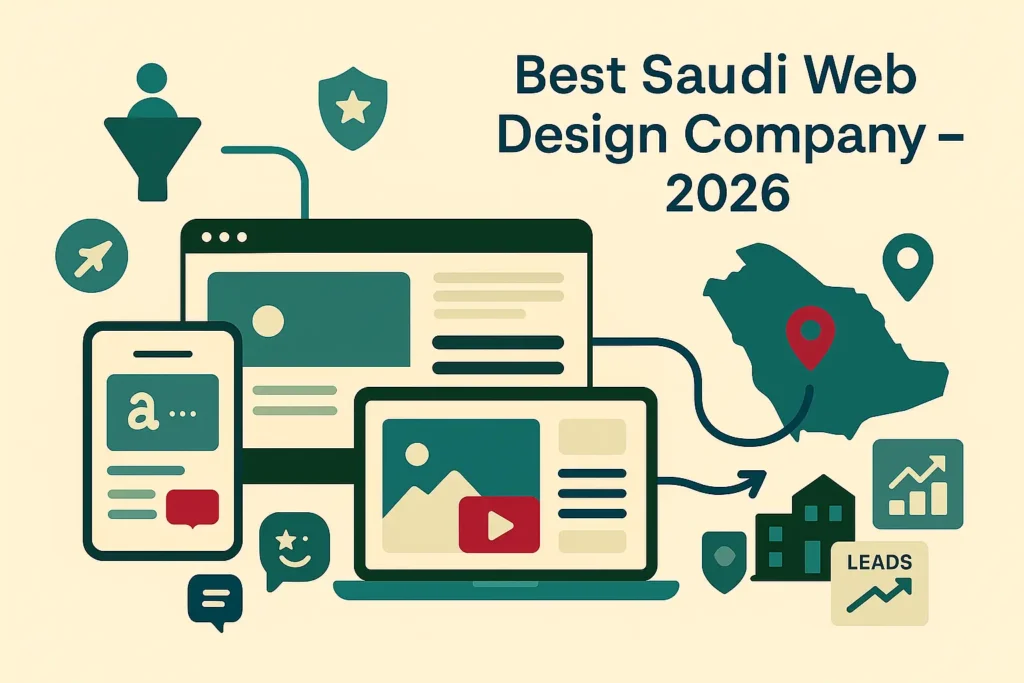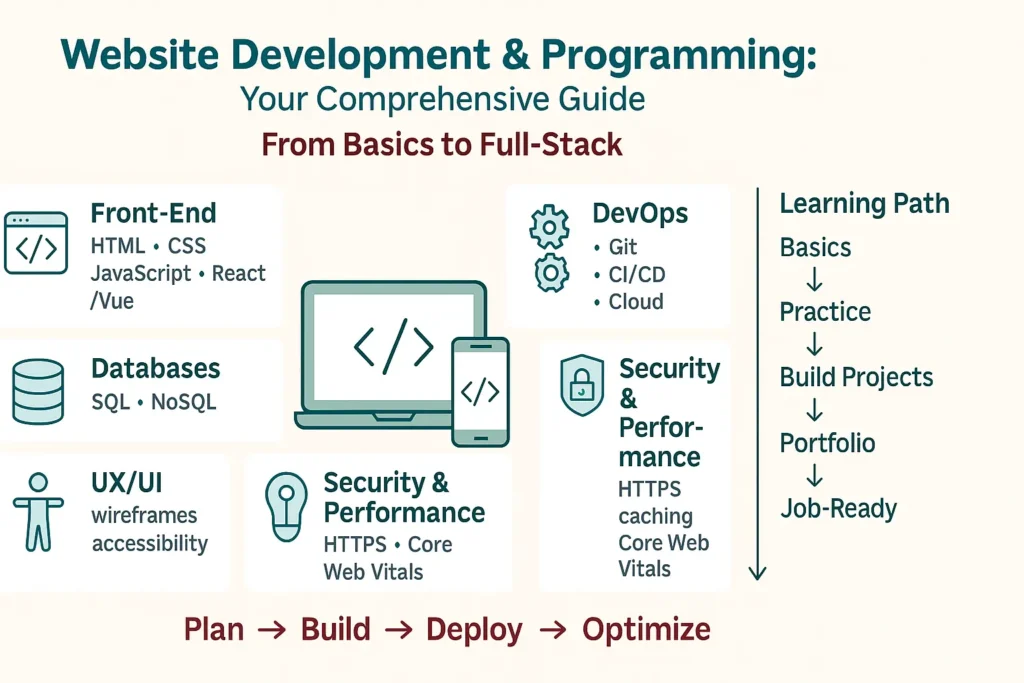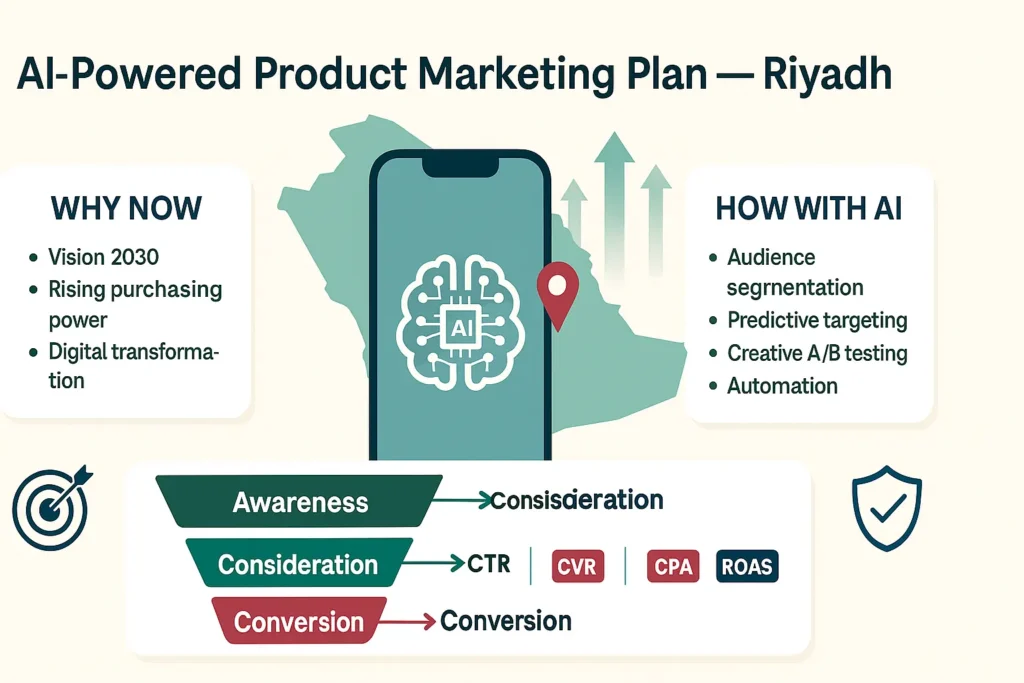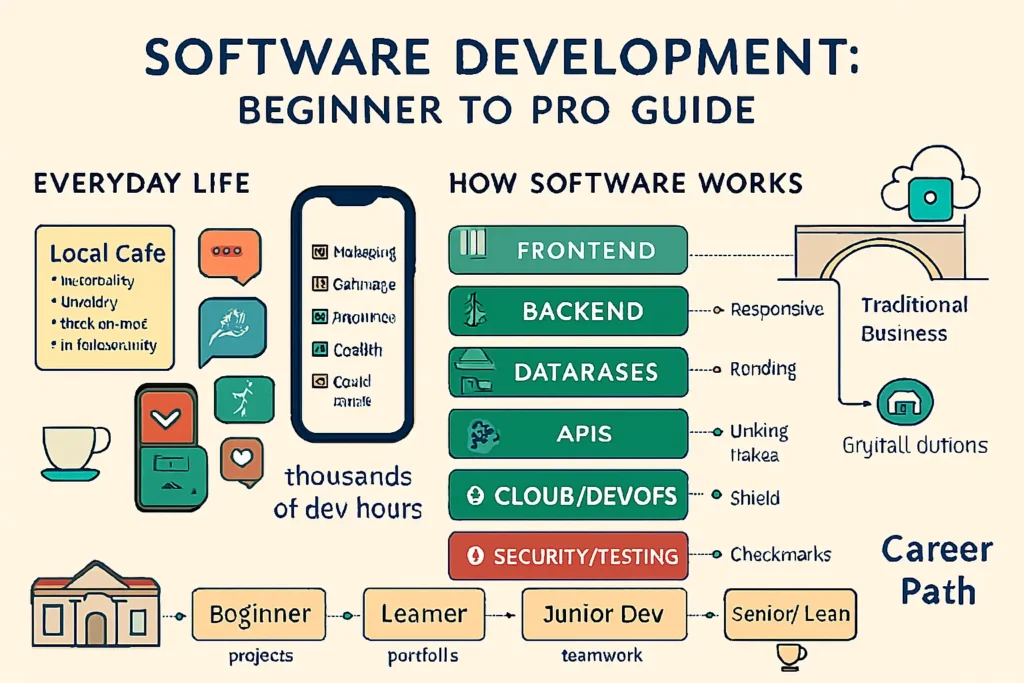
What Is Software Development? A Comprehensive Guide for Beginners and Professionals
Software Development: Beginner to Pro Guide
You wake up every morning, check your smartphone for messages, use apps to order coffee, navigate traffic with a mapping system, and run your business through multiple digital platforms. Every single one of your interactions with technology represents thousands of hours of software development work behind the scenes. These digital shifts don’t just change how you live—they also create unprecedented opportunities for those who understand how to build the software that powers our modern world.
The gap between traditional business processes and digital solutions has never been wider, and companies across every sector are eagerly looking for skilled professionals who can bridge it. Whether you’re an absolute beginner curious about entering the field or a seasoned professional who wants to deepen your understanding, software development is one of the most promising career paths of our time.
Consider this: just two decades ago, most businesses were run primarily through in-person interactions and paper-based systems. Today, even your neighborhood café relies on sophisticated software to manage inventory, run customer loyalty programs, process payments, and market via social media. This massive transformation has created an insatiable demand for software solutions—making skilled developers some of the most sought-after professionals in the global economy.
Definition of Software Development and Its Fundamentals
When you think of software development, you might picture programmers typing cryptic code on black screens. The reality is far broader—and far more exciting. Software development encompasses the entire process of ideating, specifying, designing, programming, documenting, testing, and maintaining applications, frameworks, and other software components.
At its core, software development is large-scale problem solving. You identify real-world challenges faced by people or businesses, then create digital solutions that address those problems more efficiently than traditional methods. The difference between simple “coding” and software development lies in scope and methodology. While coding focuses on writing instructions, software development spans the entire lifecycle from initial concept to ongoing maintenance.
Every successful software project starts with understanding user needs. You don’t begin by choosing a programming language or framework—you begin with a deep grasp of the problem you’re trying to solve. This may involve analyzing business processes, interviewing users, studying competitor solutions, or identifying gaps in existing systems. Only after this thorough analysis do you start the technical work of building the solution.
A software developer’s responsibilities extend far beyond programming. You become a digital engineer who designs scalable systems, a problem analyst who fixes complex issues, a collaborator who works with cross-functional teams, and a lifelong learner who adapts to rapidly evolving technologies. This multifaceted nature makes software development both challenging and highly rewarding.
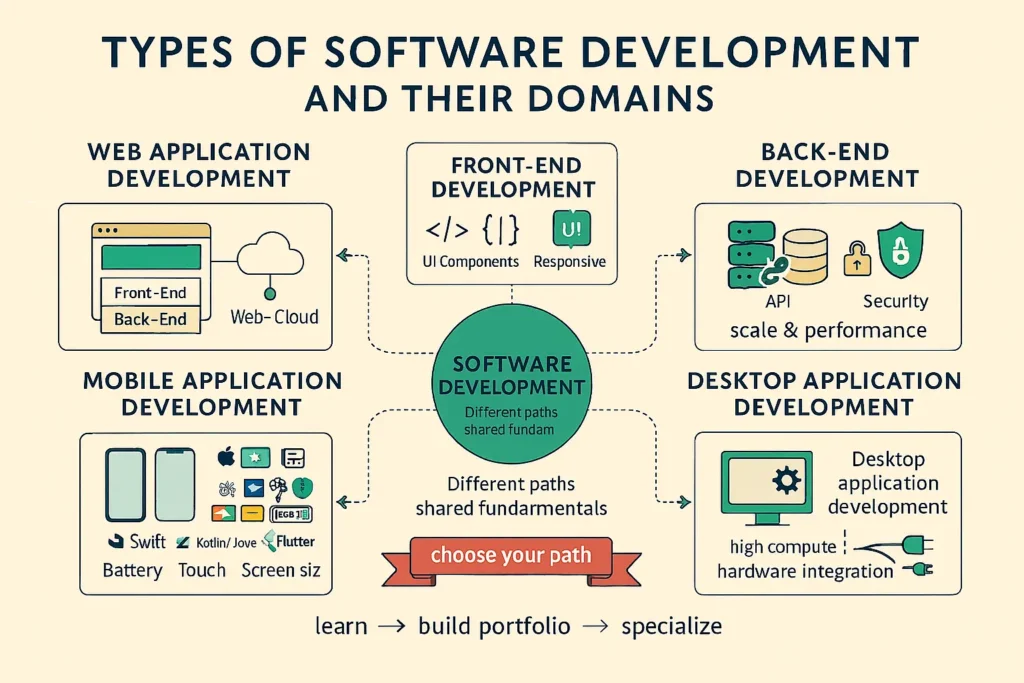
Types of Software Development and Their Domains
Your journey in software development may lead you to specialize in specific domains, each with its own challenges, tools, and unique opportunities. By understanding these different paths, you can make informed decisions about where to focus your learning and career growth.
Web Application Development
Web application development is one of the most accessible entry points into software development. You build programs that run in web browsers and are accessible from any internet-connected device. This field splits into front-end development—where you focus on user interfaces and experiences—and back-end development—where you build the server-side logic that powers applications.
Front-End Development
Front-end developers design the visual and interactive elements users see and interact with. You’ll work with technologies like HTML for structure, CSS for styling, and JavaScript for interactivity. Your work directly impacts the user experience, making interfaces intuitive, responsive, and visually engaging across different devices and screen sizes.
Back-End Development
Back-end development involves building the server-side infrastructure that front-end applications communicate with. You’ll design databases, create APIs, implement security measures, and ensure applications can handle many users simultaneously. Back-end developers often work with languages such as Python, Java, or Node.js, and focus on performance, scalability, and data management.
Mobile Application Development
Mobile development has become essential with the widespread adoption of smartphones. You can choose between native development—building specifically for iOS using Swift or for Android using Kotlin/Java—or cross-platform development using frameworks like React Native or Flutter. Mobile app development requires understanding unique constraints like battery life, varied screen sizes, and touch-based interactions.
Desktop Application Development
Desktop application development remains important for software that requires high computational power or tight integration with specialized hardware. You might build professional tools for designers, developer IDEs, or industry-specific programs for healthcare or finance. Desktop apps often provide more direct access to system resources than web or mobile apps.
Cloud Development
Cloud development has grown in importance as businesses migrate operations online. You’ll work with platforms such as AWS, Google Cloud, or Microsoft Azure and design applications that leverage cloud infrastructure for scalability, reliability, and global reach. This specialty often requires understanding software containers, microservices architecture, and distributed systems.
The Software Development Life Cycle (SDLC)
Understanding the SDLC gives you a structured approach to building software, regardless of project size or complexity. Each phase serves a specific purpose and contributes to overall success.
1) Planning and Requirements Gathering
This phase lays the foundation for everything that follows. You collaborate with stakeholders to understand business goals, user needs, technical constraints, and project timelines. The outcome is detailed documentation that becomes the roadmap for all development activities. Weak planning frequently leads to project failure, making this stage essential.
2) Analysis and Design
Here you translate requirements into technical specifications. You make architectural decisions about how components will interact, select appropriate technologies, design database schemas, and create prototypes or mockups. This phase demands balance between technical feasibility, business needs, and user experience.
3) Development and Programming
This is where you write the code that implements your designs. You break complex requirements into smaller tasks, deliver features incrementally, and regularly integrate your work with contributions from teammates. Modern development practices emphasize collaboration, code quality, and automated testing throughout this phase.
4) Testing and Quality Assurance
Testing ensures your software meets requirements and works correctly under varied conditions. You’ll implement unit tests for individual components, integration tests for component interactions, and end-to-end tests that simulate real user scenarios. Testing should begin early and continue across the entire project lifecycle.
5) Deployment and Release
Deployment makes your software available to users. You configure production environments, set up monitoring, and create processes for continuous updates. Modern release practices often use automation to push changes with minimal downtime.
6) Maintenance and Updates
Work continues long after the first release. You fix bugs found by users, add features based on feedback, update dependencies for security, and tune performance as usage patterns change. Maintenance often represents the largest share of a software project’s total cost.
Software Development Methodologies
Choosing the right development methodology has a major impact on your project’s success. Different approaches suit different team sizes, project types, and work cultures.
Waterfall (Traditional)
The traditional Waterfall methodology follows a linear sequence in which each phase must be completed before the next begins. You gather all requirements up front, then produce comprehensive designs, implement the entire system, and finally test and deploy. While this approach provides clear milestones and documentation, it can struggle when requirements change or unexpected challenges arise.
Agile
Agile promotes iterative development and responsiveness to change. You work in short cycles called sprints, regularly delivering working slices of software. Agile emphasizes stakeholder collaboration, adaptation to feedback, and continuous improvement. It fits projects where requirements may evolve or where fast delivery provides competitive advantages.
Scrum
Scrum provides a structured framework for implementing Agile principles. Cross-functional teams work with defined roles such as Product Owner and Scrum Master. Regular ceremonies—including daily stand-ups, sprint planning, reviews, and retrospectives—maintain focus and foster continuous improvement. Scrum works especially well for teams building complex products with multiple stakeholders.
DevOps
DevOps emphasizes collaboration between development and operations teams. You implement practices like continuous integration, automated testing, and infrastructure as code. DevOps aims to shorten development cycles while maintaining high software quality and reliability. This approach particularly benefits teams that deploy software frequently.
Selecting the Right Methodology
Selecting a methodology depends on factors like team size, project complexity, stakeholder availability, and organizational culture. Many successful teams adapt methodologies to fit their specific context rather than following any approach rigidly.
Tools and Technologies Used
A developer’s effectiveness depends heavily on mastering the right tools and technologies. The landscape evolves continuously, but several categories remain consistently important.
Programming Languages
Programming languages are your primary medium for instructing computers. Popular choices include Python for versatility and readability, JavaScript for web development, Java for enterprise applications, and Swift for iOS. Rather than trying to learn every language, focus on mastering one or two that align with your chosen specialty.
Integrated Development Environments (IDEs)
IDEs provide comprehensive facilities for software development. Tools like Visual Studio Code, IntelliJ IDEA, or Xcode offer syntax highlighting, debugging, and integrated version control. Choosing the right IDE can dramatically improve your productivity and code quality.
Database Management Systems
Databases store and organize the data your applications rely on. You might work with relational databases such as PostgreSQL or MySQL, or NoSQL options like MongoDB or Redis. Understanding database design principles and query optimization becomes critical as your applications scale.
Version Control Systems
Version control systems like Git help you track changes to your codebase, collaborate with team members, and maintain different versions of your software. Platforms such as GitHub, GitLab, or Bitbucket provide cloud-hosted Git repositories with additional collaboration features.
Frameworks and Libraries
Frameworks and libraries offer prebuilt functionality that streamlines development. Web frameworks such as React, Angular, or Django handle common tasks like routing, authentication, and data management. Knowing when to leverage existing solutions versus building custom implementations is a key skill.
Testing and Deployment Tools
Testing and deployment tools automate quality assurance and software delivery. You’ll use testing frameworks to verify your code works correctly and deployment tools to distribute updates efficiently and securely.
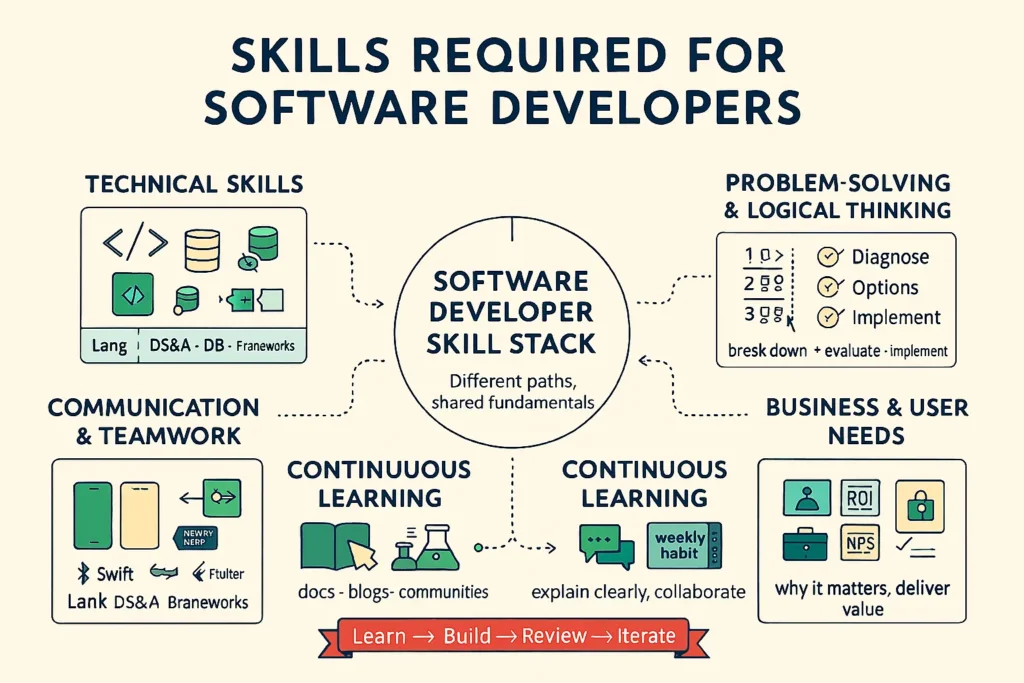
Skills Required for Software Developers
Succeeding in software development requires a blend of technical competencies and communication skills that enable effective collaboration and continuous learning.
Technical Skills
Technical skills form the foundation of your development capabilities. You need proficiency in at least one programming language, an understanding of data structures and algorithms, knowledge of database design principles, and familiarity with development tools and frameworks related to your specialty. However, technical skills alone don’t guarantee success.
Problem-Solving and Logical Thinking
Problem-solving and logical thinking are perhaps the most important abilities for any developer. You’ll regularly face challenges that require breaking complex problems into manageable parts, analyzing multiple potential solutions, and implementing the most suitable approach. Strong problem-solving skills help you adapt to new technologies and handle unfamiliar challenges.
Continuous Learning
Continuous learning is essential in a rapidly evolving field. You must stay current with new technologies, best practices, and industry trends. This includes reading technical documentation, following industry blogs, participating in online communities, and experimenting with new tools and frameworks.
Communication and Teamwork
Communication and teamwork grow increasingly important as your career advances. You’ll collaborate with other developers, explain technical concepts to nontechnical stakeholders, and participate in code reviews. Clear communication prevents misunderstandings and ensures everyone works toward shared goals.
Understanding Business and User Needs
Understanding business requirements and user needs leads to software that actually solves real problems. The best developers grasp not only how to implement features, but also why those features matter to users and organizations.
Job Opportunities and Career Paths
The field of software development offers diverse career tracks with excellent growth potential and competitive compensation. Understanding these opportunities helps you plan your professional development strategically.
Employment in Companies
Software development roles within companies provide stability and structured career advancement. You might start as a junior developer, progress to senior developer, team lead, and eventually become an architect or engineering manager. Large organizations often offer comprehensive benefits, training programs, and clear promotion paths. However, corporate environments may involve less variety in projects and technologies.
Freelance Software Development
Freelancing offers flexibility and potentially higher rates. You can choose projects that interest you, work with diverse clients, and set your own schedule. Successful freelancers build strong business skills that include client communication, project management, and marketing. However, freelancing requires self-discipline and often entails irregular income.
In-Demand Specializations
Different specialties within software development command varying market demand and compensation. Full-stack developers, who can work across front-end and back-end technologies, are highly sought after. DevOps engineers who bridge development and operations often earn premium salaries. Mobile app developers remain in strong demand as companies keep investing in mobile experiences.
Salary Expectations
Salaries vary widely by location, experience level, and specialization. Junior developers in major tech hubs might earn between $70,000 and $90,000 annually, while experienced developers can earn $150,000 or more. Specialized skills—such as machine learning or blockchain—often command higher compensation.
Building a Strong Portfolio
A solid portfolio is essential for career advancement. Showcase a range of projects that demonstrate your technical skills, problem-solving ability, and adherence to best practices. Contributing to open-source software, building personal projects, and maintaining an active GitHub profile all help establish your reputation.
Common Challenges in Software Development
Every software developer faces similar challenges throughout their career. Understanding these obstacles—and their solutions—helps you navigate your development journey more effectively.
Managing Deadlines and Pressure
Deadlines and pressure are constant factors. Projects often have tight schedules, and stakeholders may not fully appreciate the complexity of building robust software. Improve your estimation skills, communicate realistic timelines clearly, and break large projects into manageable milestones to keep delivery on track.
Handling Changing Requirements
Evolving requirements frustrate many developers, especially those new to the field. Clients may not fully understand their needs early on, or business conditions change mid-project. Agile methodologies help manage shifting requirements by embracing iterative development and regular stakeholder feedback.
Ensuring Code Quality and Application Security
Maintaining code quality and application security grows increasingly important as systems become more complex. Balance rapid development with comprehensive testing, implement security best practices from the start, and keep your code clean and readable so other developers can understand and modify it.
Keeping Up with Technological Change
Staying current can feel daunting given the pace of change. Focus on core concepts that remain relevant across technologies rather than chasing every new framework or tool. Choose a few areas for deep specialization while maintaining awareness of broader industry trends.
Practical Solutions
Join developer communities for support and knowledge sharing, set aside dedicated time for learning and professional development, and seek mentors who can provide guidance based on real-world experience.
Keep reading and uncover secrets that can change the way you work. How Does a Software Company Help Improve Your Project?
Future Trends in Software Development
Understanding emerging trends helps you make informed decisions about skill development and career planning. While the future is hard to predict, several trends show strong momentum and potential impact.
AI in Software Development
AI is transforming how developers work. AI-assisted coding tools help generate code, identify bugs, and suggest improvements. Machine learning applications are becoming common across industries, creating demand for developers who understand AI concepts and frameworks.
No-Code and Low-Code Platforms
No-code and low-code platforms enable nontechnical users to build applications through visual interfaces. These tools won’t replace traditional development, but they are changing how some apps are built and who can build them. Developers who know when and how to leverage these platforms gain a competitive edge.
Cloud Computing, Containers, and Edge
Cloud computing and containers continue to reshape software architecture. Understanding microservices, containerization with Docker, and cloud platforms is increasingly important. Edge computing brings processing closer to users, creating new opportunities and design challenges.
Internet of Things (IoT) and Smart Devices
IoT expands software development beyond traditional computers and phones. Developers are working more with embedded systems, smart home devices, industrial sensors, and automotive applications—domains that require knowledge of hardware constraints and real-time systems.
Augmented and Virtual Reality
AR and VR are creating new classes of applications with unique UI and performance requirements. Though still maturing, these technologies show strong growth potential in gaming, education, training, and business applications.
Keep reading and uncover secrets that can change the way you work. Discover How an App Design Company in Saudi Arabia Can Help You
Practical Steps to Start Your Software Development Journey
Beginning a career in software development can feel overwhelming given the vast number of choices and technologies available. A structured approach helps you build skills efficiently and enter the job market successfully.
Choose the Right Specialization
Your first specialization should align with your interests, market demand, and career goals. If you enjoy visual design and user experience, front-end development may suit you. If you prefer working with data and system architecture, back-end development may be best. Mobile development offers excellent opportunities if you’re interested in reaching a broad consumer audience.
Recommended Learning Resources
Learning resources vary in format and depth. Online platforms such as freeCodeCamp, Codecademy, and Coursera provide structured learning paths. YouTube channels offer free tutorials on nearly every technology. Technical books deliver deep conceptual understanding, while intensive bootcamps provide focused, specialized training.
Build Your First Programming Project
Creating your first project gives you hands-on experience and material for your portfolio. Start with something simple but complete, such as a personal website, a to-do app, or a basic calculator. Focus on implementing core functionality before adding advanced features. Document your process and code clearly to demonstrate your thinking to potential employers.
Join Developer Communities
Joining developer communities accelerates learning and provides networking opportunities. Local meetups, online forums like Stack Overflow and Reddit, and social media groups connect you with experienced developers who can answer questions and offer guidance. Contributing to discussions and helping others also builds your reputation.
Tips for Beginners
Focus on fundamentals before tackling more complex topics, practice coding regularly rather than only in occasional bursts, and don’t be afraid to break things while experimenting. Embrace debugging as a learning opportunity, and remember that every professional developer started as a beginner.
Keep reading and uncover secrets that can change the way you work. How to Website Programming Professionally by Expert Hands
Your Ongoing Development: Sustaining Success in the Software World
Success in software development isn’t about reaching a final destination—it’s about embracing continuous growth throughout your career. Developers who thrive over decades treat learning not as a pre-work phase but as a core part of their professional identity.
Continuous Skill Development
Ongoing skill development remains vital throughout your career, not just during the initial learning phase. Technology evolves rapidly, and the frameworks you master today may be less relevant in five years. Foundational skills in problem-solving, architectural thinking, and learning strategies remain valuable across technological shifts. Successful developers reserve time for experimentation, side projects, and exploring emerging technologies.
Staying Current with Technology
Staying current requires a focused strategy rather than trying to learn everything. Choose a few areas for deep specialization while keeping awareness of general trends. Follow industry leaders on social media, subscribe to relevant newsletters, and attend conferences or webinars when possible. The goal isn’t to become an expert in every new technology, but to understand how new developments might affect your work and career.
Building a Strong Professional Network
A strong professional network becomes increasingly valuable as your career progresses. Relationships with other developers, mentors, and industry professionals create opportunities for collaboration, job referrals, and knowledge sharing. Participate in open-source projects, contribute to technical discussions online, and maintain relationships with colleagues from different roles and projects.
Investing in Your Future
Think beyond immediate job requirements. Consider how your skills could transition into leadership roles, entrepreneurial projects, or emerging fields. Some developers move into technical writing, developer relations, or product management. Others start their own companies or become consultants. Keep options open by developing both deep technical expertise and broad business understanding.
The Road Ahead
The future of software development looks very bright. As digital transformation accelerates across industries, skilled developers will continue to enjoy strong job security, competitive compensation, and the satisfaction of building solutions that improve people’s lives. Whether you’re just starting or advancing your current career, software development offers immense opportunities for growth, creativity, and impact.
Turn your goals into real achievements with our tailored services – request the service now.
Frequently Asked Questions
What is the best programming language for beginners to start with?
Your first language should match your goals and interests. Python offers excellent readability and flexibility, making it ideal for beginners who want to focus on core programming concepts without heavy syntax. JavaScript provides immediate visual feedback through web development and remains highly relevant for job opportunities. Java teaches solid programming foundations and object-oriented principles, though it’s more verbose. For mobile development specifically, consider Swift for iOS or Kotlin for Android. Remember: your first language won’t be your last—focus on transferable programming concepts rather than finding a “perfect” choice.
How long does it take to learn software development?
Timelines vary widely by goals, available time, and learning style. With consistent daily practice, you can build basic programming skills in 3–6 months, create simple projects in 6–12 months, and reach job-ready levels in 12–24 months. Mastery takes years of ongoing practice and learning. Intensive bootcamps compress learning into 12–24 weeks but require full-time commitment. Self-learning offers flexibility but typically takes longer. Consistency matters most—one hour of coding daily beats sporadic binge learning. Prioritize building projects and solving real problems over merely completing tutorials.
Do software developers need a college degree?
Many successful developers have computer science degrees, but a degree is not strictly required. Employers increasingly value demonstrable skills and experience over formal credentials. A strong portfolio, open-source contributions, and proven problem-solving ability often matter more than diplomas. Degrees can still help with structured learning, networking, and qualifying for some roles (especially at large firms). Bootcamps and online certifications offer practical alternatives. Ultimately, your ability to write clean, effective code and solve real problems is what employers value most.
What’s the difference between a front-end and a back-end developer?
Front-end developers focus on what users see and interact with directly. You’ll use HTML for structure, CSS for visual design, and JavaScript for interactivity; you’ll build responsive designs that work across devices, optimize user experience, and implement UI designs.
Back-end developers build the server-side infrastructure that powers applications—working with databases, APIs, server configuration, and business logic—focusing on data management, security, scalability, and system architecture.
Full-stack developers work across both, though they may not specialize as deeply in either. Both paths offer excellent career prospects—choose based on whether you prefer user-facing work or systems architecture.
How can I land my first software development job?
Combine technical skills, a strong portfolio, and strategic job searching. Build a portfolio with 3–5 projects that showcase different skills and technologies; include at least one more complex project showing real-world problem-solving. Contribute to open source to demonstrate collaboration and experience with existing codebases. Establish a professional online presence (GitHub, LinkedIn, and possibly a personal site). Network through local meetups, online communities, and social media. Consider internships or apprenticeship programs for structured entry paths. Prepare for technical interviews by practicing coding problems and being ready to discuss your projects in depth. Don’t overlook smaller companies and startups, which may be more willing to take a chance on newcomers. Expect rejections—use feedback to improve and keep applying consistently.
